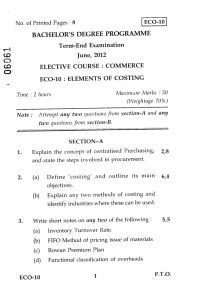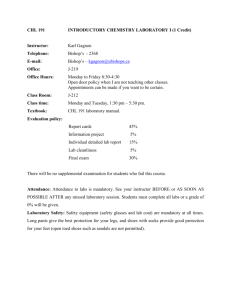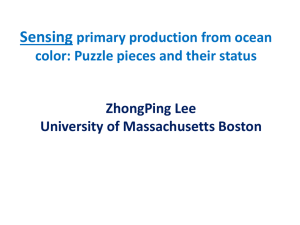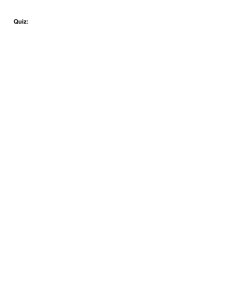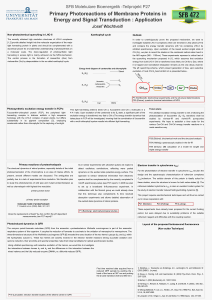FINAL 2014 CHL PIHOA 7.47 MB
advertisement
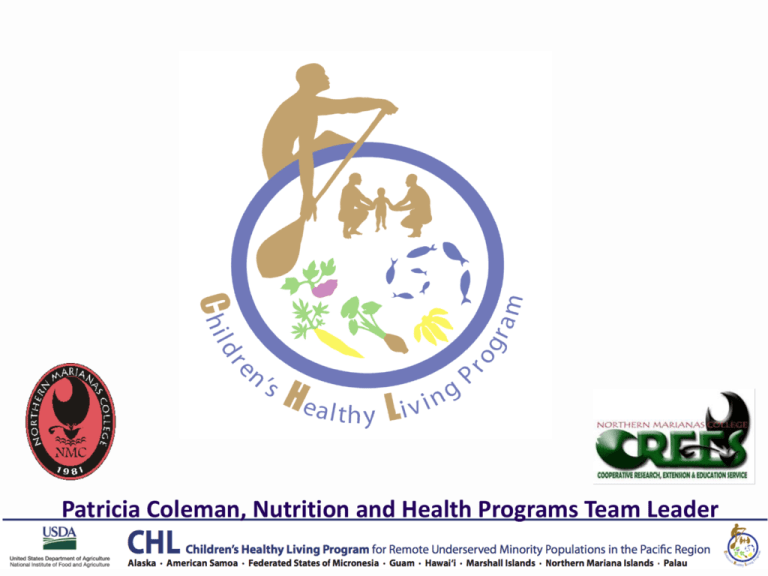
Patricia Coleman, Nutrition and Health Programs Team Leader PREVALENCE OF YOUNG CHILD OVERWEIGHT AND OBESITY IN THE US AFFILIATED PACIFIC REGION: A META ANALYSIS FROM THE CHILDREN’S HEALTHY LIVING PROGRAM (CHL)* RACHEL NOVOTNY1, MARIE KAINOA FIALKOWSKI1, FENFANG LI1, DONALD VARGO2, YVETTE PAULINO3, PATRICIA COLEMAN4, ANDREA BERSAMIN5, CLAUDIO R NIGG1, JODI LESLIE1, RACHAEL LEON GUERRERO3, JONATHAN DEENIK1, JANG KIM4, LYNNE R WILKENS1 1UNIVERSITY OF HAWAII, 2AMERICAN SAMOA COMMUNITY COLLEGE, 3UNIVERSITY OF GUAM, 4NORTHERN MARIANAS COLLEGE, 5UNIVERSITY OF ALASKA, FAIRBANKS Introduction: US NHANES is not conducted is US Affiliated Pacific (USAP) Region (USAP Islands, Hawai`i , Alaska). Method: A meta-analysis of published literature and publicly available agency reports was conducted to estimate overweight and obesity prevalence of 2-8 year (y) old USAP children. Contiguous US data (NHANES) served as reference. Literature search was limited to resources in English and 2-8y USAP children data from 2000 to 2013 and used CDC 2010 overweight and obesity reference data. USAP region sources (n=23) and NHANES articles (n=3; the contiguous U.S reference) included. Data were disaggregated into single years of age. The children measured for the age group were divided equally and the prevalence was assigned to each individual age. A mixed model regressed the prevalence on a polynomial in age, accounting for the prevalence variance and another model compared jurisdictions. Results: Overweight plus obesity increased from 21% at 2y, to 39% at 8y (p<0.0001) for the USAP. In comparison, combined overweight plus obesity increased from 24 % at 2y to 35% at 8y (p<.0001) for NHANES. USAP data showed with a sharp increase in prevalence at 5y. Obesity alone increased from 10% at 2y, doubling to 24% at 8y (p<0.0001)whereas overweight prevalence was stable from 2y (13%) to 8y (15%). Discussion: Further examination, monitoring and understanding of USAP young child obesity is needed. *TO BE PRESENTED AT AMERICAN SOCIETY OF NUTRITION ANNUAL MEETING IN SAN DIEGO, APRIL 2014 & ABSTRACT PUBLISHED IN FASEB JOURNAL. PAPER SUBMITTED TO AJPH. Methods • Meta-analysis of published literature and publicly available agency reports for Hawaii, Alaska, and US-Affiliated Pacific Islands • English only, 2-8 year olds • Year 2000 & newer, CDC overweight and obesity reference data • Data disaggregated into single years of age Methods cont. • Children measured for the age group were divided equally and prevalence was assigned to each individual age • Mixed model regressed the prevalence of a polynomial in age Results • OWOB increased from 21.0% at 2y to 39.2% at 8y (p<.0001) for the USAP • NHANES increased from 24.2% at 2y to 34.8% at 8y (p<.0001) • Sharp increase in prevalence at age 5y • USAP obesity alone increased from 10.2% at 2y to 23.6% at 8y (p<.0001) CHL Population U.S. Affiliated Pacific Region Need • Obesity - minimal data, no NHANES • Capacity - few trained professionals • Unique geography and culture - need culturally tailored approach CHL Annual Meeting, Guam June 2013 7 CHL Vision We envision sustainable community-based systems and environments to raise healthy children in the Pacific Region Children from the Republic of the Marshall Islands CHL Mission In partnership with our community, our mission is to elevate the capacity of the region to build and sustain a healthy food and physical environment to help maintain healthy weight and prevent obesity among young children in the Pacific region Tafuna Elementary, American Samoa, April 2013 CHL Goal The goal of CHL is to build social/cultural, political/economic, and physical/built environments that will promote active play and intake of healthy food to prevent young child obesity in the Pacific Region Children from Yap State, Federated States of Micronesia External Advisory Committee Jennifer Anderson Kathryn Kolasa Suzanne Murphy Wendy Snowdon Boyd Swinburn Principal Investigator Novotny Program Steering Committee Lead Site Co-I : Deenik, Kim, Bersamin, Leon-Guerrero/Barber, Novotny, Vargo/Ropeti Performance Sites FAS: FSM, RMI, Palau; CNMI; Alaska; Guam; Hawaii; Am. Samoa Coordinating Center Program Director: Novotny Assistant Program Director: Fialkowski Program Administrator: Yan Conference Coordinator: Chun IT Manager: DeBusk Local Advisory Committees LG Dir. Chair: Currie, Samson, Taro; Manglona; Sparrow, Yudin, Gallo, Aga Data Center Lead: Wilkens Data Coordinator: Li Training / Education Center Lead: Dunn / Fialkowski Education Coordinator: Leslie / Delormier External Communication Center Lead: Hollyer / Takahashi Intervention Center Situation Analysis Center Lead: Fialkowski / DeBaryshe Lead: Nigg / Braun Intervention Coordinator: Butel CHL Target Population • Grant requirement: children ages 2 – 8 y – – – – – – – – Head Start Preschool Day Care Kindergarten Community Health Centers Community Centers Images from CHL brochure, courtesy of Center on the Community Events Family Supplemental Feeding Program for Women, Infants, & Children CHL Objectives 1. Conduct program / data inventories & situation analysis – Situation Analysis Work Group 2. (Degree) Train 22 professionals & paraprofessionals in obesity prevention – Training Work Group 3. Develop Pacific food, nutrition & physical activity data management & evaluation system – Data & External Communications Work Groups 4. Develop & conduct an environmental intervention (to prevent, maintain or decrease young child overweight & obesity in the Pacific Region) – Intervention and External Communication Work Groups 5. Evaluate the community - based primary - prevention environmental intervention – Data Center Work Group 6. Incur at least one obesity prevention policy change per state / jurisdiction – Program Steering Committee Work Group CHL (6 behavioral outcomes, 3 health outcomes) Primary 1. Sleep by 15 min/day 2. Moderate to vigorous physical activity by 10 min/day 3. Fruit & vegetable intake by 1 serving/day (1/2 c/day) 4. Water intake by ½ cup/day 5. Sedentary behavior (screen time) by 10 min/day 6. Sweetened beverage intake by ½ cup/day 1. Prevalence of obesity by 8% (0.10 kg/m2 decrease in BMI z- score) 2. Waist circumference by 2% Secondary 3. Acanthosis nigricans by 5% Positive acanthosis nigricans screen, CHL Study Effective Evidence-Based Strategies from Randomized Controlled Trials Decrease in SSB intake Policies to ban SSB Product & shelf labeling Increase in F/V intake Increase in water intake Decrease in leisure screen time Policies: Policies to Policies to promote F/V promote water reduce screen consumption intake time Product & shelf labeling Increase access to clean Water Increase in PA Increase in sleep Policies to promote PA Change Built Environment to promote PA Gardening Healthy lifestyle Education Healthy lifestyle education Healthy lifestyle education Healthy lifestyle education Healthy lifestyle education Healthy lifestyle education ANGELO –Analysis Grid for Elements Linked to Obesity (Swinburn and colleagues) CHL SITUATIONAL ANALYSIS & SCAN MERGE PRIORITIZE FORMULATE Action Plans Demographic, health, risk, and other data Strategies from: Importance Community suggestions to address obesogenic environments Physical Social Policy Community Do-ability Scientific literature Literature GOALS Healthy Eating 1. Decrease in SSB intake 2. Increase in water intake 3. Increase in fruit & vegetable intake Physical Activity 4. Decrease in leisure screen time 5. Increase in sleep 6. Increase in physical activity Top Strategies from Communities (Nov 2011-Feb 2012) Overall Priorities 1. Educate parents, siblings, grandparents, children, communities on healthy living Alaska Am Sam CNMI Guam X X X X X X X X X X X X X X X X X X 2. Importance of family, teachers, leaders, other respected figures as role models setting a healthy living example 3. Better and more free community activities and resources to promote healthy living 4. Community resources maintained and accessible during all times making physical activity easier Hawaii 5. Improve drinking water access/facilities X X X X 6. School policies need to be changed to make school lunches healthier, encourage water intake, increase physical activity, and reduce sugar sweetened beverage X X X X X X X X X X X 7. Change government policies to promote healthy lifestyle, prohibit use of food stamps to buy junk food, control stray dogs and moose 8. Limit screen time 9. Healthy local-grown, garden-fresh produce should be easily accessible and affordable X X X X MERGE -- Much of what the community wants is supported by the literature Supported by Supported by literature community Policies Access to water Environmental changes for PA Healthy living education Product and shelf labeling Access to affordable produce (including gardening) X X X X X X X X X X X PRIORITIZE - Communities prioritized the merged list of strategies (May-June 2012) Merged list of strategies posted on flip chart paper Presented to 10 selected communities, 2 each in: • • • • • Alaska American Samoa CNMI Guam Hawaii Participants prioritized based on • • Importance Feasibility (Do-ability) FORMULATE– Intervention Community Action Planning (LAC) 1. Bring together key stakeholders, including parents, teachers, and leaders to implement the strategy 2. Adapt the strategy to the locale 3. Promote and implement the strategy 4. Establish a mechanism to monitor fidelity and outcomes 5. Use data to improve implementation Other communities are testing interventions to reduce childhood obesity, AND they are willing to share their materials and ideas! In implementing these strategies, CHL: • Partners with, supports, and “adds value” to existing programs that are conducting activities related to our 6 behavioral outcomes. • Builds local capacity to sustain programs and policy changes. • Promotes a common CHL message. • Collects data on the timeline of implementing strategies and on the extent to which strategies are implemented at given time points. Cross-cutting Functions 1. Review assessment data for policy & physical environment related to the 6 CHL behaviors 2. Partner & advocate for environmental change 3. Promote the CHL message 4. Train the trainers CHL Intervention: Cross-Cutting Functions, Activities & Behavioral Targets Review Assessment Data for Policy & Physical Environment related to the 6 CHL behaviors a. Review preschool wellness policy assessment data to identify training needs b. Review community assessment data to identify areas for advocacy for PA env. Partner and Advocate for Environmental Change a. Work with coalitions to advocate for i. Better access to parks that are safe & inviting ii. Better access to clean water iii. Safer environments for walking & biking iv. Better food placement in stores v. Gardens & hydroponics b. Partner with existing entities to purchase or obtain sponsorship for i. Water in the preschools ii. Gardening supplies for preschool kids iii. Sports equipment for preschool kids iv. Campaigns & messages Promote the CHL Message a. Support role models to deliver CHL messages in various b. Enhance existing social marketing campaigns related to 6 CHL behaviors c. Advertise CHL or other activities that promote 6 CHL target behaviors Train the Trainers a. Train individuals to promote gardening in preschools & communities b. Train individuals to lead interactive, hands-on, & family-based sessions c. Train preschool providers on wellness policies d. Train preschool providers in curricula related to 6 CHL target behaviors e. Train role models (community champions, role celebrities, role models) ↓ SSB ↑ F/V ↑ PA X X X X X X ↑ ↓ ↑ Water Screen Sleep X X X X X X X X X X X X X X X X X X X X X X X X X X X X X X X X X X X X X X X X X X X X X X X X X X X X X X X X X X X X X X X X X X X X X X X X CHL TEAM CNMI Jang Ho Kim, Tayna Belyeu-Camacho, Rose Castro, Jesse Deleon Guerrero, Marilynn Duenas, Randall Nelson, & me 25 CNMI work w/role models (RM) • Village focused instead of CNMI-wide focus • RM identified by key informants, knowledge of community • Empowerment of stakeholders/role models • Training and technical support • Building on assets, strengths, influences of role model group—integral role in driving the intervention • Diverse backgrounds Village Logos TASA Role Models Enhancing the Built Environment in Kagman Policy: Child Care Licensing Regulations Policy & Advocacy • Require each child care center to have policies that focus on the implementation of the CHL behaviors • Require procedures/plans for implementation • Align inspection checklist with policy requirements • Mobilize partners for support • Get approval from governor Training • First training slated for Maydemonstrate burden of COWOB, critical role they playget buy-in • Include child care administrators, owners, managers, and child care providers • Write the policy in • Subsequent trainings to focus on implementation of one or two CHL behaviors • CCDF benefits Prevalence Survey Freely Associated States: Palau, Marshalls, Chuuk, Kosrae, Pohnpei, Yap • Determine the prevalence rates of underweight, overweight, and obesity in a representative sample of young children, ages 2 – 8y, from each jurisdiction • Provide descriptive information on similar measures as CHL Intervention Study • Approximate sample size 200 per jurisdiction Marshalls, Kosrae, Pohnpei, Chuuk, Yap, Palau) • Data: Anthropometry, Acanthosis Nigricans, Accelerometry, Questionnaire (Sleep etc...),Food and Activity logs, Community obesity prevention environmental assessment, Food & Utility cost survey • Most Survey elements completed in Pohnpei (Oct 28-Nov 8, 2013) and RMI ( Jan 1-Feb 4, 2014) • Palau survey: April 7-18, 2014; Chuuk Survey July 14 to Aug 14, 2014; Yap October 2014; Kosrae Jan 2015 31 Capacity Building Through Training I. CHL Scholarship Program Provide academic degree training for indigenous students in CHL region- 2 from each jurisdiction, including 2 from each state of Freely Associated States of Micronesia II. CHL Capacity Building Program for the Pacific Region Help develop sustainable, culturally appropriate, nutrition courses & programs & within existing academic institutions in the region CHL Students – Cohort 1 CHL Students – Cohort 2 CHL Phases Phase 1: Situation Analysis • Inventories • Community Meetings • Community Readiness Training Phase 2: Measurement •Participant •Community •Data entry Phase 3: Intervention 3,919 •Implementation •Monitoring •Data entry Phase 4: Measurement •Participant •Community •Data Entry Phase 5: Evaluation, Dissemination, Policy & Data Systems Development Children’s Healthy Living Program Environmental Changes Social/Cultural Env. Examples: •Family, teachers, church leaders, other respected role models setting example of healthy living Political/Economic Env. Examples: •Influence leash laws Physical/Built Env. Examples: •Ensure water fountains are available & maintained Promote Outcomes Healthy Food Intake Obesity Prevention • Decrease in sugarsweetened beverage intake • Increase in water intake • Increase in fruit and vegetable intake Overall Outcome: Healthy Young Child Physical Activity • Decrease in recreational screen time • Increase in sleep • Increase in physical activity 36 Si yu’us maase yan olomwaay!
